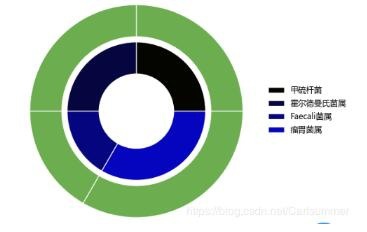Python drawing ring graph method
The examples in this article share the specific code for drawing a circular graph in python for your reference. The specific content is as follows
import os
import pandas as pd
import matplotlib.pyplot as plt
import random
import numpy as np
# Get a list of gradient colors
def gradual(number):
colors =[]
h =0.00001
gradual2 = random.uniform(0,1)
r = gradual2
if gradual2 =0.5:
g = h
b = gradual2
else:
g = gradual2
b = h
colors.append((r, g, b,1))for i inrange(number -1):
# Greater than 0.5 is a green gradient, less than a blue gradient
if gradual2 =0.5:
g =1if((1- h)/ number)1else(g +(1- h)/ number)else:
b =1if((1- h)/ number)1else(b +(1- h)/ number)
colors.append((r, g, b,1))return colors
# Get the number of green,standardRedIndex is to change that color to red
def listGreen(number, standardRedIndex):
colors =[]for i inrange(number):if i == standardRedIndex -1:
colors.append('r')else:
colors.append('#6CAD4F')return colors
# Draw a ring chart
def circularGraph(outerData, innerData, labels, standardRedIndex):
data = pd.DataFrame([outerData, innerData], columns=labels)
# Set the font so that it can display Chinese
plt.rcParams['font.sans-serif']='Microsoft YaHei'
plt.rcParams['axes.unicode_minus']= False
plt.figure(figsize=(8,5))
colors =gradual(len(labels))
# Data inner loop
plt.pie(data.iloc[1,:], radius=0.65, wedgeprops=dict(width=0.3, edgecolor='w'), colors=colors)
# Data outer loop
plt.pie(data.iloc[0,:], radius=1, wedgeprops=dict(width=0.3, edgecolor='w'),
colors=listGreen(len(labels), standardRedIndex))
# Get ax label
ax = plt.subplot(1,1,1)
# loc is the location, bbox_to_Anchor is the position coordinate, borderaxespad puts the legend outside frameon=False remove the legend border
# bbox_to_y coordinate of anchor
y =-1/40*len(labels)+0.5
ax.legend(labels, loc=4, bbox_to_anchor=(1.3, y), borderaxespad=0., frameon=False)
plt.show()circularGraph([30,30,20,40,20,20,40,20,20,40,20],[30,30,20,40,20,20,40,20,20,40,20],['Methiobacillus','Holdmania','Faecali','Rumen bacteria','Faecali','Faecali','Rumen bacteria','Faecali','Faecali','Rumen bacteria','Faecali'],3)

For more exciting content, please click on the topic: "Python Image Processing Operations"
The above is the whole content of this article, I hope it will be helpful to everyone's study.
Recommended Posts